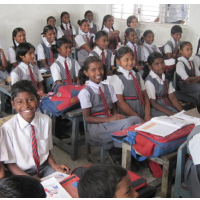India Nears Gender Parity in Classroom, But Lags Behind in Adult Literacy
 The girls-to-boys ratio in primary classes is 1.02 now (file photo: Indian Express)
The girls-to-boys ratio in primary classes is 1.02 now (file photo: Indian Express)
The good news is India has made significant progress in the last 15 years in boosting school enrolment, and is also close to gender parity in the classroom, according to a global report by UNESCO. The bad news, however, is the country is lagging behind in adult literacy and in checking the growth of private schools in urban slums.
The Education for All Global Monitoring Report 2015 notes that the girls-to-boys ratio in India’s primary classes is already 1.02 while that in secondary school is 0.94.
“In fact, India is predicted to be the only country in South and West Asia to have an equal ratio of girls to boys in both primary and secondary education,” says the report, released in Delhi by HRD Minister Smriti Irani on Thursday.
India has brought out-of-school children down 90 per cent since 1999. Gross enrolment in pre-primary education touched 58 per cent in 2012, in comparison to 19 per cent in 1999.
“Improvements in early childhood education, universal primary education, the huge reduction in out-of-school children and gender equality are big achievements for India, a country where more that 220 million children are in schools,” said Aaron Benavot, the report’s chief author.
Irani said initiatives to improve enrolment and “a new paradigm of education that fosters knowledge, analytical skills, vertical reasoning and the ability to imagine beyond the given is being adopted”. Enhanced focus was being laid on science and mathematics, she said.
However, the report cites the 2014-15 Annual Status of Education Report (ASER) to point out wide disparities in students’ basic skills across states, and highlights the growing number of contract teachers and teacher absenteeism.
In 2014, the proportion of all children in class 5 who could read a class 2 textbook was up by a minuscule 1.1 percentage points – from 47% in 2013 to 48.1% in 2014. This implies that every second class 5 student in rural India cannot read the text of a class 3 levels below, the ASER report said.
UNESCO’s report also criticizes India on three counts: the large number of illiterate adults, the quality of learning outcomes and the mushrooming of private schools in urban slums.
Of the 781 million illiterate adults worldwide, 265 million are Indians, the report said.
“The one measurable goal that India did not reach was to reduce its illiteracy rate by 50%… Women represent the majority of illiterate adults with 68 per cent of illiterate adults in India being women,” it noted.
- Karan Singh
To Learn More:
India’s schools now have an equal ratio of girls and boys, and that’s a big deal (by Rama Lakshmi, Washington Post)
Progress on gender equality in schools, universal education: Unesco (by Prashant K. Nanda, Mint)
Gender parity in Indian class, 90% out of school are now in (by Shikha Sharma and Ruhi Tewari, Indian Express)
Gender equality: India lags neighbours on several counts (CNBC-TV18)
- Top Stories
- Controversies
- Where is the Money Going?
- India and the World
- Appointments and Resignations
- Unusual News
- Latest News
- India College Chain’s Expansion into U.S. Draws Opposition from Massachusetts Officials over Quality of Education
- Milk Shortages in India Tied to Release of New Movies Featuring Nation’s Favorite Stars
- Confusion Swirls around Kashmir Newspaper Ban in Wake of Violent Street Protests
- Polio-Free for 5 Years, India Launches Vaccine Drive after Polio Strain Discovery
- New Aviation Policy Could Increase Service, Lower Ticket Prices






Comments